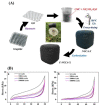Graphene-Based Aerogels for Biomedical Application
- PMID: 38131953
- PMCID: PMC10743039
- DOI: 10.3390/gels9120967
Graphene-Based Aerogels for Biomedical Application
Abstract
Aerogels are three-dimensional solid networks with incredibly low densities, high porosity, and large specific surface areas. These aerogels have both nanoscale and macroscopic interior structures. Combined with graphene, the aerogels show improved mechanical strength, electrical conductivity, surface area, and adsorption capacity, making them ideal for various biomedical applications. The graphene aerogel has a high drug-loading capacity due to its large surface area, and the porous structure enables controlled drug release over time. The presence of graphene makes it a suitable material for wound dressings, blood coagulation, and bilirubin adsorption. Additionally, graphene's conductivity can help in the electrical stimulation of cells for improved tissue regeneration, and it is also appropriate for biosensors. In this review, we discuss the preparation and advantages of graphene-based aerogels in wound dressings, drug delivery systems, bone regeneration, and biosensors.
Keywords: bilirubin adsorption; biosensor; drug delivery; graphene aerogel; hemostasis; wound healing.
Conflict of interest statement
The authors declare no conflict of interest.
Figures








References
-
- Kistler S.S. Coherent Expanded Aerogels and Jellies. Nature. 1931;127:741. doi: 10.1038/127741a0. - DOI
-
- Liu Q., Yan K., Chen J., Xia M., Li M., Liu K., Wang D., Wu C., Xie Y. Recent advances in novel aerogels through the hybrid aggregation of inorganic nanomaterials and polymeric fibers for thermal insulation. Aggregate. 2021;2:e30. doi: 10.1002/agt2.30. - DOI
-
- Zhi D., Li T., Li J., Ren H., Meng F. A review of three-dimensional graphene-based aerogels: Synthesis, structure and application for microwave absorption. Compos. Part B Eng. 2021;211:108642. doi: 10.1016/j.compositesb.2021.108642. - DOI
-
- Cao X., Zhang J., Chen S., Varley R.J., Pan K. 1D/2D nanomaterials synergistic, compressible, and response rapidly 3D graphene aerogel for piezoresistive sensor. Adv. Funct. Mater. 2020;30:2003618. doi: 10.1002/adfm.202003618. - DOI
Publication types
LinkOut - more resources
Full Text Sources

